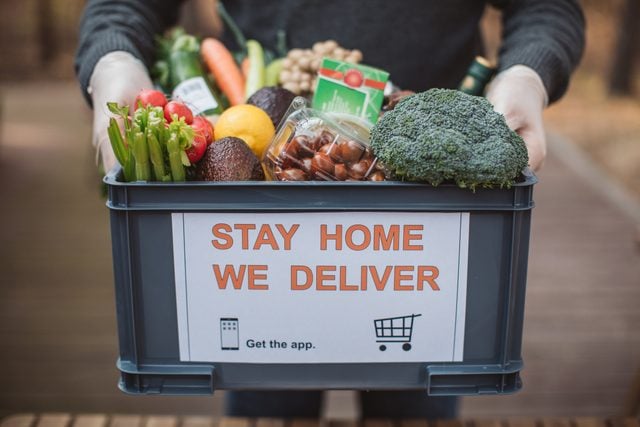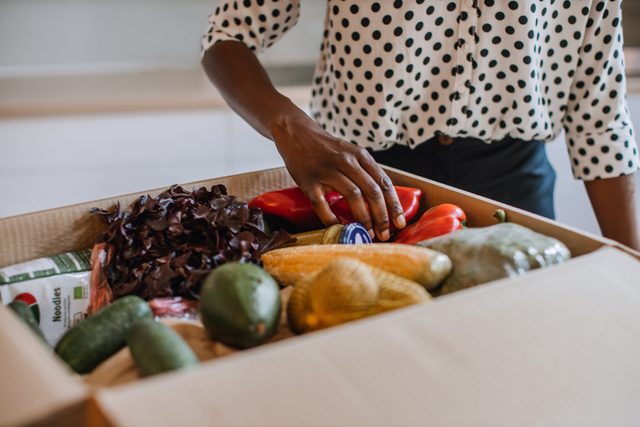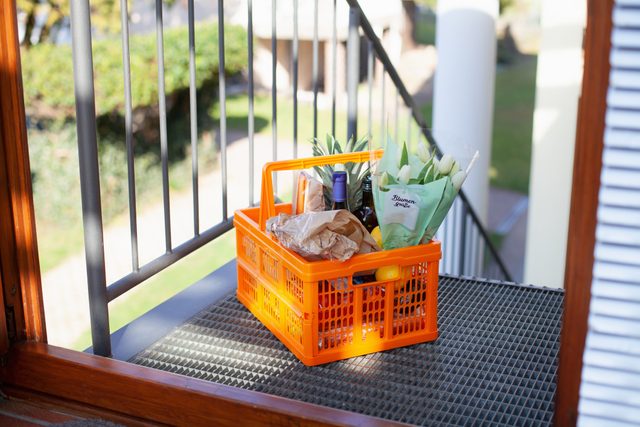The 7 Best Ways to Get Groceries Delivered
Updated: Apr. 22, 2020
Health experts weigh in on the best grocery delivery services to use during Covid-19 quarantine to stay healthy.
Thanks to the Covid-19 pandemic, getting groceries may now feel like a part-time job. And with the Centers for Disease Control and Prevention’s recommendation of face coverings in public (to prevent coronavirus spread), you may feel safer opting for a delivery service than going to the supermarket. Pre-pandemic, grocery delivery services were seen as an indulgence, but now they’re essential for many people.
You a greater chance of Covid-19 exposure at the grocery store. This includes everyone from shoppers to the stock person, the guy or gal behind the deli counter, and the cashier. Here’s how you can safely shop for groceries.
“Anyone who is a high-risk individual, meaning they have a weaker immune system, should not be going to the grocery store,” says Toby Amidor, RD, a food safety expert and author of The Create-Your-Plate Diabetes Cookbook. “This includes pregnant and lactating women and people who are immune-compromised or have underlying diseases like cancer, asthma, or other such diseases.”
Older adults should minimize visits to the grocery store, too. “If they do choose to go, they should use the hours set aside for people age 60 years and older,” Amidor says. Also, leave the kids and grandkids at home—children under age six have still-developing immune systems.
If you do go to the grocery store, take precautions—meaning wear a mask and gloves, and stay at least six feet away from other people at all times. Of particular concern are grocery store carts, touch screens, and even the reusable bags you bring from home. In his studies, Chuck Gerba, PhD, a professor of environmental microbiology at the University of Arizona, found these surfaces to be the germiest. “You should always use a hand sanitizer after you use a touch screen,” Gerba says. “Reusable bags are also very germy. Many people transport other objects in them—i.e. laundry and shoes. In our interviews, only 3 percent of people said they ever washed their reusable grocery bags.” During pandemic life, you may want to opt for paper bags instead. Gerba notes they have only about a 1 percent virus transfer rate. Find out what you need to disinfect.
Now, if you do decide to use a delivery service, here are seven grocery delivery services to make your quarantine a little easier and healthier. As a registered dietitian nutritionist myself, I’m also including my personal experiences with these delivery services.

Whole Foods
Now that Amazon owns Whole Foods, this is a grocery delivery option for Amazon Prime members. If—and that’s a gigantic “if”—you can score a two-hour delivery window, there’s no delivery fee.
“Whole Foods was the way we were getting most of our groceries pre-pandemic,” says Sarah Gold Anzlovar, RDN, in Medfield, Massachusetts. “Unfortunately, after the first week of sheltering in place in the suburbs of Boston, we have been unable to get a delivery time due to high demand. I’ve had times disappear between the time I signed on and added one more thing to my cart.”
Jen Bragg, RD, a food allergies dietitian in Hoboken, New Jersey, has been fortunate to get some orders through. You’ll have the most luck with receiving some semblance of your order if you choose to accept substitutions. “An example is strawberries to organic strawberries,” she says.
If you’re one of the lucky few who grabs a spot, tip your shoppers well, advises Gold Anzlovar. “They are putting their lives at risk so you can stay home safely,” she notes.
Author experience: During the first week of self-quarantine, I was able to get a Whole Foods delivery. About 50 percent of my order was delivered, but this was likely because I have food sensitivities and decided not to allow substitutions.
Amazon Fresh
This service is free to Amazon Prime members and is becoming available in more and more areas of the country. Securing a delivery slot is a matter of perseverance. “Delivery slots open up throughout the day, so you have to continuously keep checking,” says Bragg. “Once one opens up, act quickly as that spot can disappear as you go through the checkout process. You do not have time to doublecheck what is in your cart.”
The really good news? If you score a delivery slot, you may actually receive everything you ordered! “With Amazon Fresh, you are getting the items from a warehouse,” says Bragg. “So I have not had any items so far that became unavailable after purchase.” She adds that the quality has been high. “I’ve purchased perishable and non-perishable items,” she says. “The chicken, fish, and shrimp have been fresh and packaged the same way as if I had bought them in person. I bought ice cream, which was packaged in a cooler bag.”
Author experience: My fiancé and I live together and have two Amazon Prime accounts (don’t ask). While I’ve been unable to get an order through via my account, he’s had success getting us groceries from Amazon Fresh several times. Like Bragg, we’ve received nearly complete orders.
FreshDirect
This regional northeast grocery delivery service has some lucky customers. If you had a FreshDirect DeliveryPass (a delivery subscription, which waives the $5.99-and-up delivery fee) pre-pandemic and you’d secured a weekly delivery slot, you’re likely having no problems getting orders right now. “I have been using FreshDirect for years for both personal and business grocery shopping,” says Irena Kutza, RD, and a private chef in New York City. “Currently, I have been able to get most items I need, but it requires a lot of time and effort. I check on available products and modify the order repeatedly as items become available. The items that seem to be most difficult to buy, oddly, are chicken, flour, and ice cream.” She leaves a note with her order to leave the bags by her apartment door so there’s no human interaction.
Pro tip: “Once you place your order, you can modify it up to about a day prior to delivery,” says Kutza. So keep adding items as they become available.” (Also, be sure to check out these 12 nutritious canned bean recipes.)
Author experience: Early in the pandemic, I was lucky enough to secure two FreshDirect orders—neither of which contained everything I ordered. I then bit the bullet and bought a DeliveryPass subscription. You are only able to secure a weekly delivery time slot a certain amount of time after you initially use the DeliveryPass subscription. Although I’ve pre-paid for six months of DeliveryPass service, I was only able to use it that initial time. I’ve been checking back every day for weeks and have been unable to secure another time slot.
Peapod
This grocery delivery service works with Stop & Shop, Food Lion, Giant-Landover, and other supermarkets. Delivery fees begin at $6.95 per order. Again, that’s if you can get a time slot. These are in such high demand that when you visit the website, an alert pops up that “delivery time slots are extremely limited.” Erin Palinski-Wade, RD, author of Belly Fat Diet for Dummies, notes that she’s found it impossible to obtain a delivery in northern New Jersey.
Availability may depend on where you’re located. Amidor, who lives in the New York City area, stayed up until 4 a.m. one morning to get a delivery slot. “It was on Easter morning, but I took it,” she says, noting her experience was mediocre. “I ordered over $200 worth of food, and about one-fifth didn’t arrive,” Amidor adds. She received all the fresh produce she requested—but the jarred pasta sauce, frozen veggies, pasta, ice cream, paper towels, and cleaning supplies she asked for did not arrive. On the plus side? “The order was on time, and the driver called me five minutes before he arrived and left everything outside my front door,” she says.
If your home base is in Massachusetts, you may have more luck. Jenny Shea Rawn, a dietitian in the Cape Cod area, says she reserved a spot for two weeks in the future. “We got everything in the order, except paper towels,” she says. Here are some quick healthy meals doctors make every day.
Author experience: I only tried a couple of times to secure a delivery slot but was unable to do so. My neighbors have been able to regularly get Peapod deliveries, though.

Instacart
Here’s a delivery service that allows you to get groceries from stores including ALDI, Costco, Publix, Sam’s Club, Wegmans, Sprouts, and even CVS. Instacart now has a “leave at my door option” to allow you to avoid human contact during the Covid-19 crisis. Like most grocery services, you’ll pay a delivery fee—which starts at $5.99. (See the foods nutritionists always buy at Costco.)
“I enjoy and miss grocery shopping,” says Lisa Andrews, RD, in Cincinnati. “But I have an underlying chronic condition, rheumatoid arthritis, and know that staying home and using an online service is safest.” Andrews orders from her local ALDI, which is less than a mile from her home.
Her advice: Get as early a delivery time as possible. “The later in the day items are delivered, the more likely they are to run out,” she says. She’s had difficulty procuring toilet paper and flour. Unlike some of the other delivery services that require waiting a couple of weeks to receive an order, Andrews has gotten deliveries just a few days after ordering. Melissa Mitri, RD, in Milford, Connecticut, says these days she’s typically scheduling an order anywhere from four days to a week out.
Where Gold Anzlovar lives, there’s a “Fast & Flexible” option. “This means the shopper will shop anytime between when you place your order and a specified date,” she says. “We’ve had good luck with this, and our shopper shopped three days after I placed my order.”
Another bonus of Instacart: “You can add on items up until your shopper starts preparing your order,” says Laura Krebs-Holm, RD, in Austin. “If the store didn’t have an item when I first made my order a week ago, they may have it that day as an available add on.”
However, Instacart doesn’t seem to be as well regulated as some of the other services in terms of safety. “On one of my deliveries, the driver was not wearing a mask or gloves, which I was surprised about,” says Andrews.
Author experience: While I haven’t tried Instacart yet, my parents who live in Florida have had good luck with it. They recently got a same-day Costco delivery with lots of fresh produce.
Mercato
Never heard of Mercato? You might want to get to know this service. They partner with local supermarkets to provide delivery to select cities throughout the country. Delivery fees are hefty, though: They run from $8 to $19 a month and are billed annually. So that can be as much as $228 a year.
“Our local fish market works with Mercato, and I have ordered from them,” says Gold Anzlovar. “We haven’t had any issues with items that I’ve ordered being unavailable, but I have noticed that the store’s online selection is smaller than what’s usually available at the market.”
When you order, make sure to read the product description. “I once thought I was getting a great deal on a bag of quinoa,” says dietitian Carolina Jantac, RD. “But I realized I had ordered a single serving and not the full bag I was expecting.” And be open-minded with your purchases. “I have noticed a shortage of some types of food such as flour, grains, and canned beans in my neighborhood supermarket,” says Sharon Palmer, RDN, in Ojai, California. “However, I generally found unusual things like different types of flour—e.g. spelt or quinoa—which is fine. I also found different types of whole grains, like farro or millet, which are OK to use instead of brown rice. The limited availability makes me get more creative.” Get healthy meal ideas you can make in 20 minutes.
Author experience: Like much of America, I jumped on the bread-baking bandwagon early in the quarantine. The only place I could find yeast was at a local supermarket. So I did a two-week trial through Mercato and placed an order of other pantry items I was having a hard time finding—including, surprisingly, peanut butter and jelly. Almost everything in my order came. I would have continued using Mercato if not for the hefty delivery fee.
Farm Deliveries
Are you used to having fresh produce on hand (and you should be)? Are you not used to getting groceries only a couple of times a month? Then, a weekly or bi-weekly produce box may be for you. You’ve likely seen all the articles about all the shelf-stable foods to have on hand during the quarantine. It’s great to have a supply of those, but don’t forget your farmers and your fresh produce.
Several options exist. Misfits Market says its organic produce costs 40 percent less than grocery store prices because it’s imperfect. Boxes begin at just $22, however, demand is currently so high that you must join a waitlist to obtain a box. After a first order, you can add additional discounted items to your box such as oatmeal, chocolate, and coffee. Melissa Groves Azzaro, RDN, in Portsmouth, New Hampshire, and author of A Balanced Approach to PCOS, says her experience with Misfits wasn’t so great, though. “I was really excited to try it, and it was affordable,” she says. “But many items were unusable—they were either broken or crushed.”
Another imperfect produce offering is the aptly named Imperfect Foods, beginning at $16 per produce box. You can also order meat, fish, grains, and other foods. “With Imperfect Foods, I appreciate that I can order fresh vegetables and fruits to feed my family while supporting efforts to reduce food waste at the same time,” says Tori Schmitt, RDN, in Fort Recovery, Ohio. Other produce delivery options include Farmbox, with boxes starting at $43.95, and Territory Grocery, with a box priced at $60.
You may also be able to find additional local options. Jamie Lee McIntyre, RDN, continues to buy produce from her local farm, Halas Farm Market, in Danbury, Connecticut, through which delivery is available for a $10 fee. “We have found this to be a healthy way to support our local economy, and it has been super helpful in supplementing our spaced-out grocery store trips to restock our kitchen,” she says. And Erin Hendrickson, RDN, a food waste expert in Nashville, says she’s been able to place online orders for meat, dairy, and other foods with local farmers. Stephanie S. Hodges, RDN, in Charleston, orders meat from a Virginia-based farm, Blue Cedar Beef. “I encourage individuals to try to support local farms as much as possible during this time,” she says.
Some meal-delivery services, including Sun Basket, allow you to add on items such as meat, pasta, and vegetables. “This has been hit or miss in terms of what actually ends up getting delivered, compared to what I think is coming,” says Groves Azzaro.
Author experience: Early in the pandemic, I ordered my first Misfits Market box. Unlike Groves Azzaro, my experience was mostly positive. The box was generously stocked with lots of fruits and vegetables—however, I did end up throwing away one rotting apple and some sweet potatoes that had holes in them (a potential sign of pests). I also tried the Territory Grocery box (which the company sent to me complimentarily), and all the produce was beautiful. I was particularly excited about the cauliflower, which I promptly roasted in the oven.

How to handle your groceries
If you do receive a food delivery or shipment, make sure you have the delivery person leave it outside your door. This minimizes contact with them, explains Amidor. “If you were not able to leave a tip online or on your credit card, then leave an envelope with cash outside for the delivery person—or ask them to step at least six feet back and place it on a surface where they can then retrieve it.” Here’s what you can do to prevent coronavirus.
After you’ve procured your groceries, wash your hands. “The FDA and CDC say that wiping down food packages isn’t necessary since there have been no cases of transmission of the virus through food packages or boxes,” says Amidor. However, Gerba notes you may want to run a disinfecting wipe over metal or hard plastic surfaces. “Virus transfer to the hands [from these surfaces] is around 70 percent,” he says.
Before you eat fresh produce, give it a good washing—with running water only. “Avoid washing any food with soap, detergent, or bleach, as it can be toxic,” explains Amidor. “If a fruit or vegetable has a tough exterior, like melon or potatoes, then you can opt to use a clean stiff-bristled brush. There is no need to wash eggs, as they have been pre-washed already.”
And as always, keep your kitchen as clean as possible. “This includes sanitizing countertops, handles on your refrigerator doors and cabinets, refrigerator shelves, and other areas that come in contact with food,” says Amidor. Be sure to check out the list of EPA-registered coronavirus cleaning products.
